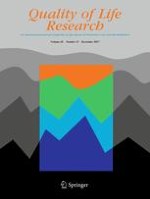03-08-2017
The significance of frailty in the relationship between socioeconomic status and health-related quality of life in the Korean community-dwelling elderly population: mediation analysis with bootstrapping
Gepubliceerd in: Quality of Life Research | Uitgave 12/2017
Log in om toegang te krijgenAbstract
Purpose
Firstly, to investigate the prevalence of frailty and impact on health-related quality of life (HRQOL) in a Korean community-dwelling elderly population using the Fried frailty criteria; secondly, to investigate the associations among frailty, socioeconomic status (SES), and HRQOL of the Korean community-based population; and thirdly, to analyze the relationship between education, income, and frailty.
Methods
Nine hundred and sixty-four apparently heathy subjects from the Korean community-based population were enrolled in this prospective cross-sectional study. Using self-reported questionnaires, demographic data, SES, and HRQOL were evaluated. Frailty status was determined according to the Fried frailty criteria. After adjustment of covariates including age, sex, and BMI, multivariate linear regression analyses were conducted to assess each component of the proposed mediation models, and mediation was also verified by the bootstrapping technique.
Results
Among the 964 participants, 530 (55.0%), 399 (41.4%), and 35 (3.6%) participants were classified into the robust, pre-frailty, and frailty group, respectively. The frail group demonstrated significantly lower HRQOL. Participants with lower income or education level had significantly higher chances of being frail. Frailty acted as a mediator in this association between low SES (education and income) and low HRQOL. Furthermore, income contributed most to the explanation of educational differences in frailty, suggesting full mediation.
Conclusion
Frailty has a significant negative influence on HRQOL in the community-based elderly population, and acts as a mediator between SES and HRQOL. As a mediator, income can explain educational difference related with the frailty.
